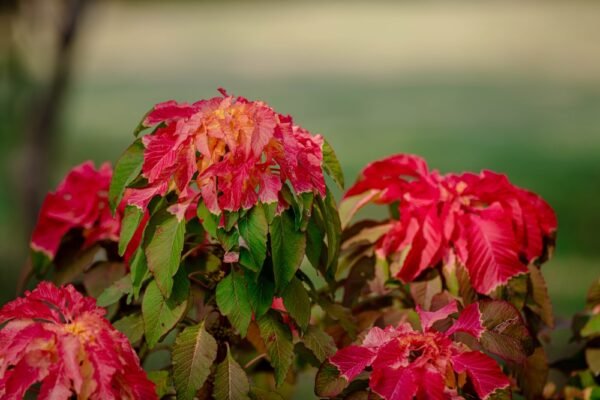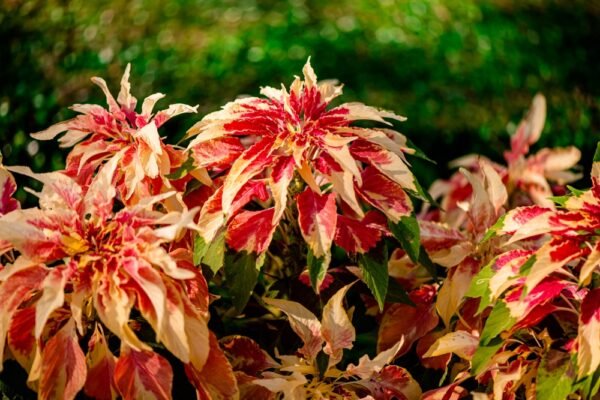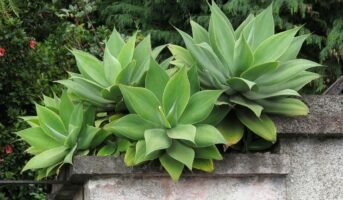What is Amaranthus Tricolor?
Amaranthus Tricolor is a beautiful plant with bright leaves. This plant has its origin in Asia and is found here in abundance. However, it is currently cultivated as a decorative plant all over the globe. These plants are low maintenance and a great option for new gardeners. The bright colours of the plant are very attractive, and it is often called the summer poinsettia.

The plant can grow upto a height of 2 feet, depending on the living conditions. Their leaves are coloured with green, yellow, and red splashes that have earned the name of ‘tricolor’. These bright colours are extremely beautiful and look like flaming leaves in the sun. These leaves are the main attraction of the plant, and it only flowers once in a while.
Amaranth greens taste like spinach and are heartier in texture. Amaranth seeds are delicious and have a nutty taste.
See also: What is mint and what are its numerous benefits?
Amaranthus Tricolor: Key facts
| Name | Amaranthus Tricolor |
| Common name | Edible amaranth, Joseph’s coat |
| Family | Amaranthaceae |
| Type | Shrub |
| Origin | South and South-East Asia |
| Indoor/Outdoor | Outdoor |
| Soil | Fertile and well-drained |
| Temperature | 20-30°C |
| Water | Plenty |
| Sunlight | Full sun or partial shade |
| Height | 2–3 feet |

Amaranthus Tricolor: How to grow?
- Amaranthus tricolor is an easy-to-grow annual, meaning you can start sowing seeds in spring and plant them out after they’ve sprouted.
- When propagating amaranth flowers, you’ll need to use containers with drainage holes for the best results.
- Make sure that your soil is well-drained and pH-balanced.
- Fill each container with potting soil, then add a small amount of bone meal.
- After planting your seeds in the containers, keep them moist until they have germinated, generally around two weeks.
- Once they’ve sprouted, transplant them into larger pots filled with a good mix of potting soil.
How to maintain Amaranthus Tricolor?
Amaranthus tricolor is a fairly easy plant to keep. It has been a favourite of many gardeners due to its bright colours. It doesn’t have a lot of demands but does need some care to grow up healthy. If you are a new plant parent, it would be better to take this plant only after gaining a little experience.
Here are some amazing cate tips for people who want to grow Amaranthus tricolor at home.
Soil
Amaranthus tricolor thrives on alkaline soils. This soil should be rich in nutrients so that the plant can grow healthy. Moist soil is preferred by Amaranthus tricolor, but it shouldn’t be soggy for too long. It is tolerant to drought and rain, but care should be taken to keep it in well-drained soil. Make sure your pot has holes and can drain out excess water if necessary.
Water
Watering an Amaranthus tricolor plant is no big deal. Since it likes moist soil, care should be taken to check the soil regularly. When the topsoil has dried up, you need to water the plant immediately. Don’t water it if the soil appears to be wet and soggy. In case of overwatering, remove the plant and cut out decayed roots before potting it in a fresh pot.
Sunlight
Amaranthus tricolor plants need plenty of sunlight to grow. They are best kept on the balcony and outdoor gardens. You can keep them on window sills as long as they receive enough sunshine.
Amaranthus Tricolor: Benefits
Ornamental and edible
Amaranthus tricolor closely resembles the plant coleus. These plants are kept in gardens because of their beautiful colours. However, given its non-toxicity, Amaranthus tricolor is also particularly well used in the culinary world. It has been a part of the staple diet of many Asian countries. It can be incorporated into dishes and turned into some amazing savouries.
What are the health benefits of Amaranthus Tricolor?
The plant also has multiple medicinal uses and is used by people who are suffering from various ailments. Here are some of the top health benefits of Amaranthus tricolor that make it an excellent medicinal plant:
Promotes digestion
Amaranthus tricolor is high in fibre content that improves gut health. Moreover, it can be extremely beneficial in relieving constipation and combating the risks of colon cancer. Since fibre is known to clear the stomach, patients suffering from these conditions are recommended to eat cooked Amaranthus tricolor leaves.
Aids weight loss
The protein and fibre content in Amaranthus tricolor can be beneficial in stabilising insulin levels in the blood. It also helps limit the appetite and prevents people from overeating. This, in turn, helps in losing weight and balancing fat.
Boosts Immunity
Amaranthus tricolor is rich in amino acids, Vitamin E, Vitamin K, Iron, and Magnesium. These nutrients help boost the immune system and protect your body from harmful diseases. It also replenishes vitamin requirements in the body and prevents nutrition deficiency.
Strengthens bones and muscles
Amaranthus tricolor has a high Vitamin K content that can help with bone growth and development. The Vitamin aurally helps improve calcium absorption, which in turn aids bone growth.
Improves heart health
Amaranthus tricolor contains phytosterols that can help in decreasing high blood pressure levels. This maintains heart health and reduces the risks of cardiovascular diseases.
See also: 21 best flowers for your garden
FAQs
Can you eat Amaranthus tricolor?
Yes, the Amaranthus tricolor plant is completely edible. It is also grown as a food staple in various parts of the world.
Where does edible amaranth grow best?
Amaranth plants thrive in ordinary to rich, well-draining soil that contains an equal amount of phosphate and nitrogen.
Can you grow Amaranthus tricolor at home?
Yes, it is completely possible to grow Amaranthus tricolor at home. They are easy to look after and don't require a lot of care.
Housing News Desk is the news desk of leading online real estate portal, Housing.com. Housing News Desk focuses on a variety of topics such as real estate laws, taxes, current news, property trends, home loans, rentals, décor, green homes, home improvement, etc. The main objective of the news desk, is to cover the real estate sector from the perspective of providing information that is useful to the end-user.
Facebook: https://www.facebook.com/housing.com/
Twitter: https://twitter.com/Housing
Email: editor@housing.com












